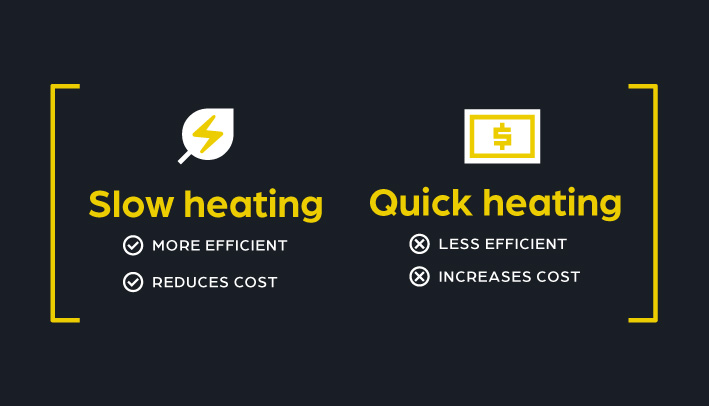 For many of us, winter brings images of glistening snow, sips of hot cocoa, fireside puzzles, and perhaps even trips with family and friends to enjoy the winterscape. But, along with the cozy nostalgia lies a bit of winter we could all do without – increased heating bills. As outdoor temperatures drop, your HVAC system works harder to maintain your desired indoor temperature. This increased demand requires more power and often leads to higher monthly utility bills; however, it isn’t a lost cause. Our team at Durastar has put together a handful of tips to save on winter heating bills.
For many of us, winter brings images of glistening snow, sips of hot cocoa, fireside puzzles, and perhaps even trips with family and friends to enjoy the winterscape. But, along with the cozy nostalgia lies a bit of winter we could all do without – increased heating bills. As outdoor temperatures drop, your HVAC system works harder to maintain your desired indoor temperature. This increased demand requires more power and often leads to higher monthly utility bills; however, it isn’t a lost cause. Our team at Durastar has put together a handful of tips to save on winter heating bills.
Evaluate your HVAC equipment and save money on heating bills.
When it comes to ensuring you’re getting the best performance out of your heating unit, review and service the equipment regularly. If your unit is becoming outdated, it may be time to discuss more energy-efficient heating solutions with your contractor. Likewise, servicing your equipment before winter increases performance. For example, something as simple as a clogged filter may significantly slow the airflow and require additional energy for your unit to keep up.
Service your furnace before the cold weather hits.
To get the most out of your furnace this winter and boost energy savings, we recommend a few basic maintenance tasks. Have a heat pump? Jump to the next section about how to service your heat pump for winter.
Consider hiring a technician for a pre-winter inspection and service.
Durastar recommends contacting your trusted service provider for a yearly inspection and cleaning of your furnace. This ensures there is no buildup or duct leaks which could result in premature deterioration of your equipment and higher power usage. Be sure to ask for a thorough report and a system overview – both will help you become more acquainted with your equipment.
Replace your filter and check it every few weeks.
Frequently replacing filters increases the furnace’s lifespan and reduces the energy required to heat your home. Not to mention, a clogged filter reduces the air quality. This is one of the easiest ways to save on winter heating bills.
Program your thermostat and check the batteries.
Today, most thermostats are programmable. That means you can set it up to automatically lower your home’s temperature during specific periods of the day. For example, while everyone is at work or during the night. Using this feature also helps reduce large and costly temperature jumps that may happen if you simply turn the heat off when you leave and back on when you return. To explain, it is more energy-efficient to slowly and incrementally increase your home’s temperature than it is to do it quickly. This is another reason why using your system’s programmable function can help you reduce winter utility costs.

In addition to this, we recommend replacing the batteries of your thermostat at the beginning of the cold season. That way, you avoid the risk of it running out of power and waking up to a frigid home. Beyond a bad case of the shivers, if the thermostat batteries are drained, then your furnace will have to work doubly to get the home back up to a comfortable temperature.
Clean around the furnace.
Many of us are familiar with spring cleaning, however, winter cleaning is a thing too! Ensure the area around your furnace is clear of debris and clutter. Not only does this allow room for a contractor to service your unit, but also it creates adequate airflow for the combustion of the heating element and enables safer operation of the furnace.
Like replacing the oil in your car, a consistent pre-winter furnace checklist is a must to keep it in tip-top shape, no matter its age.
Service your heat pump before cold weather hits.
With proper maintenance and seasonal inspections, your heat pump will help save energy year after year so you can save on winter heating bills. To prepare your heat pump for winter, here are a few items to address.
Schedule a technician to perform general maintenance and an inspection.
If you’re aiming for premium energy savings, a surprise-free winter, and long-lasting equipment that runs like new for years to come, then we highly recommend scheduling a yearly heat pump inspection. Your trusted technician will ensure all belts, blowers, coils, and moving parts are working properly. They will also inspect refrigerant lines, test electrical connections, and much more.
Check your air filters and replace them when dirty.
Avoid the urge to let your heat pump filter get extremely clogged before replacing it. In the long run, replacing your air filter more frequently will extend the life of your equipment. Furthermore, it will maintain a higher air quality throughout your home and reduce the power output necessary to maintain the set indoor temperature.
Pro tip: Vacuuming an air filter might make it appear to be cleaner, however, this is not the recommended approach because the deeper filter layers will remain clogged and require your system to work harder.
Clean the area around the outdoor equipment and when possible, remove dirt from the coils, fans, indoor registers, and other surfaces.
Before the snow falls, remove vegetation, clutter, and other debris surrounding your outdoor heat pump. Then, wipe clean any accessible parts, including coils, fan blades, and the equipment itself. When you inspect your interior heat registers, straighten any bent fins and remove dust.
Consider replacing your outdated equipment with a higher-efficiency system from Durastar.
Sometimes, you can follow all of the recommendations for saving money on your heating bill without seeing the impact you were aiming for. In that case, it may be time for an equipment upgrade. Although this requires an upfront investment, the long-term savings will be beneficial. Look for a furnace or heat pump with a high AFUE rating. AFUE is the standard efficiency rating. It stands for Annual Fuel Utilization Efficiency. Similar to comparing the amount of miles per gallon in a car, the AFUE represents how efficiently your heating equipment uses power/energy. The higher the rating, the more energy savings you’ll achieve.
If an equipment upgrade is in your future, then review our article, I need a new HVAC system, now what? We outline three steps to help you kickstart the process of upgrading your heating and cooling units.
At Durastar, we believe in providing comfort for everyone. From supporting a wide range of budgets to ensuring your heating and cooling preferences are met, customers can rest easy, knowing our vast selection of HVAC products will provide peace of mind, year after year. Built to last and tested to perform, you can depend on Durastar for premium, energy-efficient HVAC equipment. Talk to your contractor today and discuss the potential energy savings gained from upgrading your furnace or heat pump.